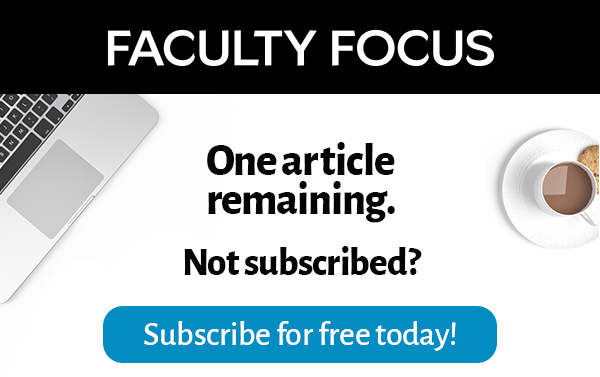This article first appeared in the Teaching Professor on August 1, 2018. © Magna Publications. All rights reserved.
English Composition I at New Jersey City University (NJCU) is designed to prepare students to meet the requirements of writing for university course work. The course learning objectives focus on the achievement of basic communicative skills in reading, writing, speaking, and listening. Instead of completing a traditional essay and/or oral presentation as the signature assignment for the course, students were asked to build a website using skills honed over the course of the semester in both traditional and non-traditional assignments. The students then presented their sites to their classmates, Dr. Fisch, and Mr. Ward; they discussed their visions and goals for the sites, design choices, the difficulties they encountered, and what they enjoyed.
Similar projects would serve as excellent capstone works for classes in a variety of subjects. All it takes is a little bit of planning and student support.
Logistics
At the beginning of the semester, Audrey Fisch, the course instructor, provided the students with an overview of the website and social media project. Daniel Ward, an educational technologist in the Department of Online Learning, made a number of classroom visits and provided students with samples and instructions about how to create a website and how to integrate social media into their site. These instructions included guidelines for the following:
- Creating a free website on wix.com with an existing template (students were welcome to use another site, but most chose Wix)
- Creating placeholders for various components including a professional résumé
- Incorporating a blog tool to the site (the class included some blogging assignments)
- Embedding a video created with a free online video creation tool (the class utilized the free tool, FlipGrid)
- Embedding social media feeds (Twitter, Instagram–students were encouraged to create alternate, professional feeds when appropriate to carve out a new social media identity)
Throughout the semester, class time was allotted for students to ask questions, work on their designs, and collaborate on their websites. Students were also encouraged to meet with Daniel Ward to address any technical problems they encountered.
Students were given significant autonomy and flexibility in creating their websites as long as they included the following components: an About Me section; a combination of visuals and text to reflect their interests and accomplishments; a video component; and professional social media feeds. We also encouraged students to use the site to publicly record their educational and professional aspirations. Another student used her site to reflect on her personal experiences with bullying.
Some students chose to include artifacts from other assignments in the class: blog and Twitter posts, for example. Others approached the task as a wholly self-contained and self-directed project, choosing to showcase interests and accomplishments unrelated to the rest of the course material.
In addition, students were allowed full latitude in design. Given the flexibility in both design and content, the results were unsurprisingly diverse, while still offering ample evidence of positive learning outcomes. For example, one student created a site featuring his “one of a kind artistic creations in the field of digital media and architecture.” He enabled the store functionality within the website platform so that he could begin to sell his designs (on mugs, mousepads, etc.).
Another student used her site to reflect on her personal experiences with bullying. She developed a social media campaign, #ShowMeYourCrookedSmileChallenge, encouraging her audience to record a mini video singing parts of the artist J. Cole’s “Crooked Smile” and “embracing your beautiful natural self with no makeup.” Still another eschewed the personal and focused on the issue of stress; his site showcased his research into “how one can relieve stress and anxiety.”
While we worried that our open-ended requirements for the assignments would be difficult for the students to navigate, nearly all the students rose to the occasion, seizing the opportunity to express themselves in ways that more than demonstrated their traditional and non-traditional communicative skills.
Technology divides
The student-developed website was a first for many of our first-generation student body. Seventy-two percent of the students involved in this project had never created a website for themselves. NJCU is a minority- and Hispanic-serving institution located in an urban area; many of students come from urban public schools where technology resources are limited and/or where technology has not been fully embraced in the curriculum and pedagogy (Herold, 2017).
This project allowed students to merge the social media and technology skills they use in their non-academic lives with traditional academic literacy in order to create a professional platform that can be utilized throughout their academic careers and into their professional lives.
Interestingly, 88 percent of the students indicated that they were very or somewhat surprised to be asked to use social media in their composition class and 96 percent were very or somewhat surprised to be asked to build a website. In other words, they had experienced a disconnect between the digital engagement in their everyday lives and their academic work; our project broke down that divide.
Student feedback
Upon completion of the course students were asked to complete a survey to share their thoughts about the website project. Seventy-two percent of the survey respondents strongly agreed or agreed that the use of social media in the course was engaging. Eighty-eight percent believed that building a website was an engaging activity. Finally, 84 percent of the survey respondents thought that this project was their favorite course activity or among their favorite assignments in the course.
At the end of the semester, students walked away with skills, confidence, and a concrete platform to showcase themselves. One student commented on the concrete usefulness of the project: “My website is about my personal makeup artistry growth. This site will help me grow as an MUA (makeup artist) and it is a great stepping stone for me to use and expand myself.” Another addressed the broader scope of the project: “It was a chance for me to showcase myself and it was the most creative project I have ever done.”
Seventy-two percent of the students agreed or strongly agreed that they would continue to build and use their websites after the course completed, and we hope that the digital portfolio continues to serve as a vehicle to articulate, store, and display their artifacts and accomplishments.
Conclusion
As educators, at all grade levels, we have the ability to demystify these tools and to utilize an array of literacies to create more opportunities for student engagement. The website as digital portfolio is the perfect vehicle for this project, serving as a public, multimodal space in which students can shape and define a public, professional persona as they hone their reading, writing, and speaking skills.
Daniel P. Ward is an educational technologist and Audrey Fisch is a professor of English at New Jersey City University.
References
Herold, B. (2017). Poor Students Face Digital Divide in How Teachers Learn to Use Tech. Education Week, Retrieved from https://www.edweek.org/ew/articles/2017/06/14/poor-students-face-digital-divide-in-teacher-technology-training.html/






